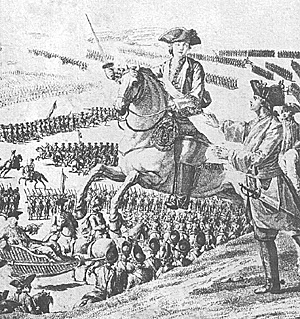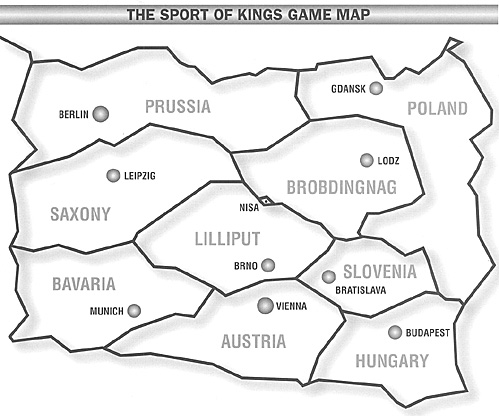
The aim of this game is to reflect the way that when nations go to war they normally do so with armed forces that are paid for and structured according to long-standing national financial, political and strategic constraints that cannot be readily or quickly reversed. When the Franco Prussian War began in 1870, for example, the French had been opting for a small professional army for some fifty years, and it was too late to change to the sort of "landwehr" force structure that allowed the Prussians to put decisively larger numbers of soldiers into the field. Hence, The Sport of Kings game was prompted by Gary P. Cox's recent book The Halt in the Mud: French Strategic Planning from Waterloo to Sedan (Boulder, Colorado, and Summertown, Oxford: Westview Press. 1994).
For the game you will need an umpire and two playing teams, representing the fictitious central European states of Lilliput (capital Brno: borders similar to the modern Czech Republic) and Brobdingnag (capital Lodz: borders roughly those of the present southern half of Poland). The umpire gives an identical briefing to each team, as well as maps of central Europe (as outlined below). Each team starts without any military forces or fortresses at all, and must decide how much money it can raise, in what timescale and on what military forces. There are very many options. For example it might invest heavily in imperishables like powder and fortifications in the first year, and then in the second year on men (who can't be stockpiled but have to be maintained anew each year). However, if the enemy opts to raise a large army and attack at once, it may leave the original country defenceless.
SCENARIO
The neighbouring powers (played by the umpire, to enable diplomatic problems to be posed, and retaliation to be exacted against international bad behaviour):
BAVARIA
Capital Munich: Strictly neutral. Armed forces: 45,000 men, relatively few fortresses.
POLAND
Capital Gdansk: Strictly neutral. As Bavaria.
AUSTRIA
Capital Vienna: Frosty to Lilliput, warm to Brobdingnag. Armed forces: 150,000 men, excellent duellists, plenty of fortresses.. ..and a small fleet.
HUNGARY
Capital Budapest: Very hostile to Lilliput, friendly to Brobdingnag. Armed forces: 20,000 men, but few fortresses.
SAXONY
Capital Leipzig: Very friendly to Lilliput,
hostile to Brobdingnag. Armed forces: 20,000 men but few fortresses.
PRUSSIA
Capital Berlin: Warm to Lilliput, frosty to Brobdingnag. Armed forces: 150,000 men, plenty of fortresses .... and a small fleet.
SLOVENIA
Capital Bratislava: Strictly neutral. Armed forces: 20,000 men, few fortresses.
Between Lilliput and Brobdingnag there is an irreconcilable border dispute over the town of Nisa, which both sides must capture.
INCOME
At the start of the game, 1st January 1735, The Kings of Lilliput and Brobdingnag each have 2,700,000 Thalers in their treasuries, on top of which they have each also just received the whole PRIVVY PURSE for 1734 and the whole TAX INCOME (800,000 Thalers) for 1734. The privvy purse is always all used to maintain the civil service and the non-military aspects of the state, so it is not played in the game. Hence each king's disposable treasure for military purposes has been topped up to its current level of 3,500,000 Thalers.
There is only one type of tax which is 'YE MUNICIPAL MULCT', which is raised each 1st January. No other type of tax is permitted in this game. Ye Mulct is drawn from all buildings and settlements of population, so that the revenue increases as the king's lands expand, and decreases as they are reduced. The king may from time to time decide to raise or lower the rate of payment for ye Mulct, and will be rewarded by the gratitude or hostility of their people (E.g. it is thought that a 50% increase will inevitably produce a revolution).
How to Raise National Finance by other means:
- 1 Investments in YE STOCK MARKETTE will pay out according to the umpire's judgement (e.g. players may place 100,000 Thalers on a horse race or football match currently taking place in the real world, and the umpire will give odds). He will not tell players that 'Pacific Rim Industrials' are doomed to collapse entirely, being just a modern way of describing ye notorious South Sea Bubble.
2 BESPOKE LOANS may also be negotiated, at varying rates of interest to be set by the umpire (usually very high), according to the case.
EXPENDITURE
Military forces must be bought new and put in place in 1735 or in subsequent years' financial rounds. Thereafter it may be built upon, re-hired, or successively reduced, according as how the king in his council shall from time to time deem necessary.
When it is bought new it will either retain its value for one year, and then have to be rebought (or re-hired) for the next year, or it may be kept permanently in place and retain its value once bought, at no extra cost to the treasury. This depends on the category of purchase into which it falls. In the following table some items - mainly based on personnel or perishable supplies - must be bought new (or re-hired) each year, incurring a new cost to the treasury at that point. Note, however, that if food is to be bought for mobile operations, and then not used, it may be sold off at coast during that year. The remaining items - mainly based on hardware or bricks and mortar - fall into the 'May be kept permanently' category (i.e. they cost nothing new each year, once they have been bought). These are asterisked in the following tariff of charges:
NOTES
1 Soldiers' foodstuffs in static garrisons are found form their pay and need not be considered. It is only the expenditure of foodstuffs and ammunition during mobile operations - or in real sieges - that will incur additional charges upon the king's treasury. Fortresses must buy in siege stocks in advance.*)
2 See Cannon tariffs for the number of rounds carried for each calibre.
- NCOs cost the same as 'men' and are automatically allocated at the rate of one corporal out of ten, one sergeant out of 30 etc.
- Commissioned Officers cost the state nothing, due to the purchase system which finances itself (all money paid in to buy a commission is eventually paid out again upon its re-sale). In each arm of service officers may be relatively numerous (at poor quality) or scarce (at high quality) depending on the level of allocation decided by the government.
 PLAYING THE GAME
PLAYING THE GAME
The umpire ensures that both sides complete each year's spending round at approximately the same time, and then he passes on as much intelligence as each player is entitled to (largely determined by how much he has spent on it). He also acts as third parties (e.g. outraged citizens, diplomatic representatives of other powers, stock exchange agents etc) and gives advice on the technicalities of play. This process continues until one side or the other goes to war. At that point the strategic movements are traced on maps using hidden movement. If it comes to a battle it may be adjudicated quickly by the umpire's decisions (and die rolls), or it may be transferred to a tabletop wargame using your own favourite set of rules.
ITEMS TO BUY NEW: THALERS NOTES
Militia Man - equipped & armed 40 rounds per man 1
Professional Infantryman - equipped & armed 3
Specialist Footguard - Engineer & etc. 5
Customs man or Gendarme - fully trained 6
Cavalryman or Dragoon - incl. horse & tack 15
Mounted & trained Staff Officer or Courier 30
Regimental Gun - gunners, horses & limberof 80 shot Man-handled 50
A confidential Correfpondant:
- in ye enemy's countrie 250
in ye enemy's great towns 500
in ye enemy's army 1000
in ye enemy's king's inner council 2500
4lb Cannon gunners, horses & limber with 40 rounds (120 rounds per wagon) 100
8lb Cannon - 30 rounds (90 rounds per wagon) 200
12lb Cannon - 20 rounds (60 rounds per wagon) 500
18lb Cannon - no limber (40 rounds per wagon) 1000
24lb Cannon - no limber (25 rounds per wagon) 1500
32lb Cannon - no limber (15 rounds per wagon) 2000
4" Howitzer & limber with 30 rounds (90 rounds per wagon) 250
8" Howitzer - 20 rounds (60 rounds per wagon) 500
12" Howitzer - no limber (40 rounds per wagon) 1000
Supply wagon
- empty but with horse team & drivers: if fully militarised 100
if civil service 50
if totally privatised 20
Wagon load of 2,000 rations for men 200(1)
Wagon load of 250 rations for horses 150(1)
Wagon load of engineer siege stores 40
Wagonload of 100,000 rounds infantry ammunition 75 j
Wagonload of artillery ammunition always militarised 100(2)
Engineer wagon with 3 pontoons, horses, drivers etc always militarised 500
Full HQ wagon - Maps, archives, generals' effects etc) always militarised 1000
Empty treasury wagon (takes 100,000 Thalers) always militarised 150
100 yards of fortress curtain wall - complete with ditch, covered way & glacis (& tenailled battery if needed) 1000
A gatehouse for the curtain wall, with drawbridge 1000
An independent magazine or bombproof shelter 500
A major bastion for the main wall 2000
100 yards of secret passageor mine gallery 200
Each story (of 6 guns) of a multi-layered battery 700
A small demi-lune or other covering outwork 1250
A small independent fort or the inner citadel for a fortress 3000
Various fortress features: innundations,retrenchments & etc variable -- ask umpire

Back to Battlefields Vol. 1 Issue 1 Table of Contents
Back to Battlefields List of Issues
Back to Master Magazine List
© Copyright 1995 by Partizan Press.
This article appears in MagWeb.com (Magazine Web) on the Internet World Wide Web.
Other articles from military history and related magazines are available at http://www.magweb.com